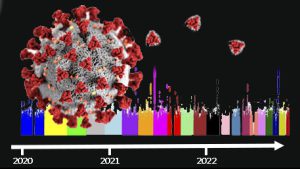Host Genomics and COVID-19: Two Years Later
Posted on by Early in the COVID-19 pandemic, we explored the rationale for host genomic studies to our understanding of COVID-19 occurrence and outcomes. Two years into the pandemic, we are taking another look. Many academic research groups and consortia—such as the COVID-19 Host Genetics Initiative (COVID-19 HGI) and COVID Human Genetic Effort—have launched worldwide open-science collaborations, featuring shared resources and rapid dissemination of research findings. One major study design for host genomics studies has been the genome wide association study (GWAS), an approach for evaluating genetic variants across the human genome for association with a disease or particular trait. GWAS of COVID-19 patients involve scanning the genome for variants associated with COVID-19 related outcomes, such as disease susceptibility and severity. GWAS results can suggest biological, prevention, and therapeutic avenues for the control of COVID-19.
Early in the COVID-19 pandemic, we explored the rationale for host genomic studies to our understanding of COVID-19 occurrence and outcomes. Two years into the pandemic, we are taking another look. Many academic research groups and consortia—such as the COVID-19 Host Genetics Initiative (COVID-19 HGI) and COVID Human Genetic Effort—have launched worldwide open-science collaborations, featuring shared resources and rapid dissemination of research findings. One major study design for host genomics studies has been the genome wide association study (GWAS), an approach for evaluating genetic variants across the human genome for association with a disease or particular trait. GWAS of COVID-19 patients involve scanning the genome for variants associated with COVID-19 related outcomes, such as disease susceptibility and severity. GWAS results can suggest biological, prevention, and therapeutic avenues for the control of COVID-19.
A 2021 review described multiple, reproducible findings from GWAS of COVID-19 susceptibility and severity. Many of the implicated genes–such as 3p21.31, IFNAR2, OAS1, OAS2, OAS3, DPP9, HLA, and TYK2—are connected to immunoregulatory pathways. These findings provide some insights into pathogenesis and potential treatment of COVID-19. For example, two variants of IFNAR2, a gene involved in the pathway for early immune response to viral infections, are associated with severe COVID-19. Increased expression of IFNAR2 was found to be protective for severe COVID-19. This finding pointed to the importance of interferons (IFNs), during the initial infection, for clearing SARS-CoV-2 and concerns about using glucocorticoids, which could inhibit IFN signaling in COVID-19 treatment. Limitations of GWAS conducted early in the pandemic included small sample size and biased selection for hospitalized or critically ill COVID-19 patients.
Two recent studies published in Nature Genetics used large sample sizes and a range of health outcomes to expand our knowledge base on host genomics and COVID-19. Roberts et al. investigated genetic factors that contribute to refined phenotypic definitions of COVID-19 susceptibility and severity. They used self-reported survey data from over 700,000 participants collected by a direct-to-consumer genetic testing service that included a large proportion with mild or asymptomatic infections. The study used granular case and control definitions for the COVID-19 phenotype and identified distinct patterns of genetic association. For example, the authors compared positive COVID-19 cases with household exposure to COVID-19 cases without household exposure to understand genetic susceptibility to study post-infection protection from severe outcomes. The study replicated associations with eight of the 12 previously reported risk loci (including one in IFNAR2) and uncovered specific associations with a range of distinct COVID-19 disease susceptibility and severity phenotypes.
In another study, Horowitz et al. performed a GWAS using self-reported and electronic health record data to define phenotypes for more than 750,000 individuals. They identified a new association with a rare genetic variant at the Xp22.2 locus (rs190509934) that downregulates the expression of angiotensin-converting enzyme 2 (ACE2). They showed that this protective variant can reduce expression of the SARS-CoV-2 receptor and decrease COVID-19 risk. Further, the authors found that a high genetic risk score (top 10%) based on common genetic variants was associated with a 1.65-fold and 1.75-fold increased risk of severe disease in individuals with and without established clinical risk factors (e.g., older age and diabetes), respectively.
The proactive approach to international collaboration and sharing of resources have enabled the discovery of previously unknown pathophysiological mechanisms of SARS-CoV-2 infection and revealed the complex genetic architecture of COVID-19. While we have made an impressive sprint to uncover the genetic anchors for response to COVID-19 infection just two years into the pandemic, the next major challenge is to use these biologic findings to inform treatment and prevention. As we head to the next phase of identifying actionable insights, it is important to acknowledge the inevitable time lag between genetic discovery and clinical implementation. It may be fruitful to recall lessons learned from past studies and the exemplars of GWAS successes. Currently, GWAS results are valuable for research purposes, but are unlikely to have a clinical value in the short term, and have a limited impact on the management of the COVID-19 pandemic thus far. The ultimate hope is to use host genetic findings to guide the development of future therapies, and enable effective prevention of severe COVID-19.
Posted on by


